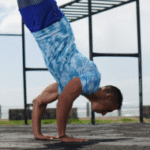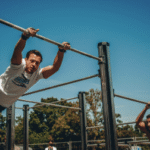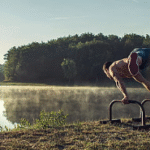Fine-Tune Your Form for Elite Calisthenics Performance
You’ve put in the hours. You can crank out pull-ups, dips, and push-ups with ease. But now you’ve hit a wall. The muscle-up feels clunky, the handstand has a persistent arch, and the front lever or planche seems like an impossible dream. Welcome to the advanced calisthenics plateau, a place every serious athlete in Houston eventually visits.
The key to unlocking the next level isn’t about “trying harder”—it’s about training smarter. It’s about refining your technique from “good enough” to flawless. This guide will detail how to fine-tune your form on the most coveted calisthenics skills to achieve elite-level control, efficiency, and performance.
Why Perfect Form is Non-Negotiable at the Elite Level
At this stage, small imperfections in form are what hold you back and lead to injury.
Efficiency and Energy Conservation: Perfect form is the most energy-efficient way to perform a movement. A “banana back” in a handstand wastes enormous energy fighting to stay balanced. A clean line conserves it.
Injury Prevention: Elite skills place immense stress on your joints and connective tissues. Imperfect form—like flared elbows in a muscle-up or an unsupported scapula in a planche—channels that stress directly into your tendons and ligaments, leading to chronic pain and setbacks.
Breaking Through Strength Plateaus: Often, your plateau isn’t a lack of raw strength, but a “leak” in your technique. By correcting your form, you engage the right muscles at the right time, allowing you to express your true strength and break through the barrier.
Aesthetics and Control: Elite calisthenics is as much an art as it is a sport. A clean, controlled movement with perfect lines is the hallmark of a true master of bodyweight strength.
The Elite Skill Breakdown: Common Flaws & How to Fix Them
Here, we break down the most common form errors in advanced skills and provide actionable drills to correct them.
- The Muscle-Up: From Clunky to Clean
The “Good-Enough” Form (The Plateau): Using a lot of “kipping” (swinging), pulling unevenly (one arm comes over before the other, a “chicken wing”), and struggling to push out of the dip.
The Elite Form (The Goal): A smooth, powerful pull high above the bar, a seamless transition with both hands turning over simultaneously, and a strong, stable dip to finish.
Common Flaw
The Fix: Drills & Cues
Lack of Explosive Power
Chest-to-Bar Pull-ups: Focus on pulling the bar to your lower chest, not just getting your chin over. This builds the necessary explosive power.
The “Chicken Wing”
Band-Assisted Muscle-ups: Use a resistance band to assist you. This slows the movement down and allows you to consciously focus on turning both wrists and pulling with both arms evenly.
Struggling in the Transition
Negative Muscle-ups: This is the #1 drill. Start at the top of the dip, and as slowly and controlled as possible, lower yourself through the transition phase and down into a dead hang.
Inefficient Grip
Master the False Grip: Practice hanging and doing pull-ups with a false grip (placing the heel of your palm on top of the bar). This positions your wrists perfectly for the transition.
- The Handstand: From “Banana Back” to a Straight Line
The “Good-Enough” Form (The Plateau): An arched lower back, bent elbows, and constantly “walking” with the hands to stay balanced.
The Elite Form (The Goal): A perfectly straight line from hands to feet, with shoulders open, core tight, and balance controlled by subtle shifts in the hands and fingers.
Common Flaw
The Fix: Drills & Cues
Arching the Lower Back (“Banana Back”)
Hollow Body Holds: Master this on the floor. The goal is to press your lower back into the ground. This feeling of a “tucked” pelvis is what you need to replicate upside down.
Shoulders Not Fully Open
Chest-to-Wall Handstands: Face the wall and walk your hands as close to it as possible. This forces your shoulders into a fully open position and builds endurance there.
Unstable, Bent Arms
Handstand Shrugs: Against a wall, actively “push” the floor away, elevating your scapula towards your ears, then relax down. This teaches active shoulder engagement and stability.
Losing Balance Constantly
Finger Drills: In a handstand hold, practice shifting your weight slightly forward and backward, using only your finger and palm pressure to correct. Your hands are your feet.
- The Front Lever: From Piking to a Floating Plank
The “Good-Enough” Form (The Plateau): Body piked at the hips, arms significantly bent, and unable to hold the horizontal position for more than a second.
The Elite Form (The Goal): A perfectly horizontal and straight body line from shoulders to ankles, with arms locked straight and scapula engaged.
Common Flaw
The Fix: Drills & Cues
Piking at the Hips
Dragon Flag Negatives: This exercise builds the immense core and lat strength needed to keep the body straight. Lie on a bench, grab it behind your head, and lower your straight body as slowly as possible.
Bent Arms
Straight-Arm Scapular Pull-Downs: While hanging from the bar, without bending your arms, pull your shoulder blades down and back. This isolates and strengthens the exact muscles needed to hold the lever with straight arms.
Lack of Scapular Depression/Retraction
Front Lever Raises (Tucked/Straddled): From a dead hang, pull your body up into a tucked or straddled front lever position. Focus on the feeling of pulling the bar down towards your hips.
Can’t Hold the Full Position
Banded Front Levers: Use a resistance band around your waist to provide assistance, allowing you to hold a perfect, full front lever for time and build specific endurance.
- The Planche: Defying Gravity
The “Good-Enough” Form (The Plateau): Hips too high, severely bent arms, and unable to get the feet off the ground for more than a moment.
The Elite Form (The Goal): Body perfectly parallel to the ground, arms locked straight, and scapula fully protracted and depressed.
Common Flaw
The Fix: Drills & Cues
Bent Arms
Pseudo Planche Push-ups: In a push-up position, lean your body as far forward as possible, bringing your hands closer to your waist. This builds immense straight-arm pushing strength.
Weak Scapular Protraction
Planche Leans: From a push-up position, lean forward as far as you can with straight arms, focusing on rounding your upper back and pushing your shoulder blades apart. Hold for time.
Insufficient Shoulder/Wrist Strength
Tuck Planche Holds: This is the foundational isometric hold. Practice it on the floor, on parallettes, or on rings to build the specific strength and conditioning needed.
Hips Shooting Up
Banded Planche: Use a resistance band looped around your hips and attached to a point above you. This provides slight assistance and helps you learn the feeling of keeping your hips in line with your shoulders.
The Ultimate Form-Correction Tool: Your Smartphone
Record, Watch, Correct, Repeat. You cannot see your own form. What feels straight is often not.
Record a video of your attempts from the side.
Watch it back immediately.
Compare it to a video of a professional performing the skill with perfect form.
Identify ONE flaw and focus on correcting only that flaw in your next set.
Repeat the process.
When to Seek an Expert Eye in Houston
While self-analysis is powerful, nothing beats the real-time feedback of an experienced coach. If you’re truly stuck, investing in a few sessions with a calisthenics or gymnastics coach at a specialized facility in Houston (like Mekanix or Calisthenics Club Houston) can be the fastest way to identify and fix the subtle flaws holding you back.
Conclusion:
Moving from an intermediate to an elite calisthenics athlete is a journey of refinement. The gains are no longer in adding more reps, but in perfecting every millimeter of your movement. By focusing obsessively on form, breaking down skills into their components, and correcting your weak links, you will not only achieve the skills you’ve been chasing but also build a stronger, more resilient, and more impressive physique.

Fine-Tune Your Form for Elite Calisthenics Performance
Route
Calisthenics Gym Houston Functional Bodyweight Training
Secondary phone: (346) 483-3195
Email: info@calisthenicsclubhouston.com
URL: https://calisthenicsclubhouston.com/
Monday 6:00 AM - 7:00 PM Tuesday 6:00 AM - 7:00 PM Wednesday 6:00 AM - 7:00 PM Thursday 6:00 AM - 7:00 PM Friday 12:00 PM - 6:30 PM Saturday 9:45 AM - 12:00 PM Sunday 3:00 PM - 5:00 PM





